Navigating the Uber Interview: Questions & Process
What to expect and how to succeed during the interview.
While Amazon and Microsoft have profited from changing consumer habits induced by the pandemic, Uber is one of the few tech giants that has struggled. Demand for its ride-hailing services fell 50-85 percent in major US cities, according to the New York Times. In May, Uber laid off nearly 7,000 employees -- about 25 percent of its staff -- and announced it would close 45 of its global offices.
If you’re considering working for Uber, expect to join a company undergoing major changes. UberEats recently surpassed Uber’s core ridesharing business in adjusted net revenue, according to a recent quarterly earnings report. Uber is also facing lawsuits in California and Massachusetts from drivers seeking to be reclassified as employees instead of independent contractors.
The company has also wound down its tech incubator and AI labs, where engineers once tested self-driving cars. Most businesses stopped testing driverless technologies during the pandemic because two people are required to ride in the vehicle to prevent accidents, which violates social distancing guidelines.
In this article, we'll cover:
- Interview process
- Tips for success
- Example interview questions
- Performance review process & refreshers
Interview Process at Uber
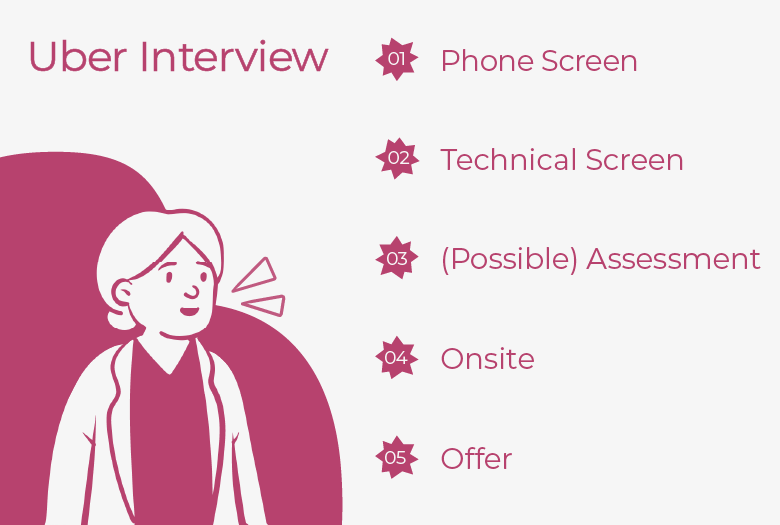
Current and would-be employees at Uber say the interview process is similar to other tech companies, like Google or Facebook. Not all interview reviews are positive-- on Glassdoor, many candidates report not receiving feedback or a formal rejection if they are dropped from the hiring process.
Phone screen with recruiter (1 hour)
Expect a standard, initial phone screen with a recruiter to discuss your work experience, career goals, and interest in the role. Beware that Uber’s phone interviews are one hour as opposed to the typical 30 minutes, so expect an in-depth discussion. During this phone call, the recruiter will also evaluate your technical skills to ensure you possess the core competencies required for the role.
When discussing your previous experiences, be sure to mention your personal contribution. Don’t just list your responsibilities or what technologies you used. Specificity is key. According to the Uber Engineering blog: ‘“I was responsible for designing our database schema and the back-end API endpoints” is a stronger response than “We built an app that showed photos.”’
👉 We know the best way to prepare for behavioral interviews. Learn more here.
Technical phone screen (1 hour)
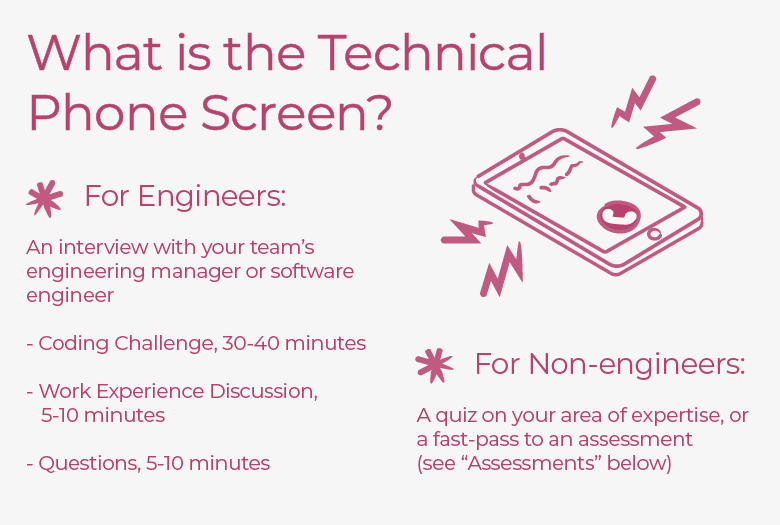
For non-engineering roles, you’ll either be quizzed on your area of expertise and/or skip straight to an assessment (see below). If you are interviewing for an engineering role, expect a technical phone screen with the engineering manager or a software engineer on the team you applied for.
Coding challenge
To put it simply, this is a coding round. Would-be developers are given 30-40 minutes to work on a coding exercise to test their knowledge of data structures and algorithms. Expect questions about string search problems, trees, string manipulation, arrays, and linked lists. The interviewer will use HackerRank, a collaborative editing software, to review your code as you type. Be prepared to write code that compiles and runs; the interviewer will have prepared several test examples for the problem to check if your code actually works.
To ace the coding challenges in your technical phone screen and onsite interview (if you are invited for one), Uber recommends that you practice as many programming problems as possible ahead of time (brush up on leetcode!). Recommended study resources include the ACM-ICPC archive from past programming contests, CodeWars, and the book Cracking the Coding Interview.
Work experience discussion
After the coding exercise, the interviewer will allocate 5-10 minutes to discuss your work experience. This portion includes behavioral questions like
Your questions
The final 5-10 minutes are reserved for you to ask your own questions. Candidates who don’t ask intelligent, thoughtful questions are perceived as less interested -- this is true at any company, but Uber specifically mentions this in its engineering blog -- so come prepared. Interview candidates should show that they're committed to finding a mutual fit, instead of accepting any old job.
👉 Learn more about the Uber data scientist interview here.
Assessments (optional)
Uber prefers to evaluate candidates’ problem-solving skills through real-world scenarios rather than brain teasers about golf balls and school buses. Depending on the position you’re applying for, expect one of the following:
Creative writing assessment
For marketing manager or community manager positions
Examples: drafting a blog post that addresses a real-world Uber scenario, such as announcing a new driver commission structure, communicating with a disgruntled customer, or de-escalating a PR fiasco.
Excel analytics test
For general manager positions
This is a 2-hour timed analytics test consisting of 32 math questions, with multiple choice and a few short essays. The questions are based on two .CSV files that candidates must download.
Coding challenges
For engineering positions
Example: asking the candidate to calculate the nearest transit stop from their current location.
Other real-world problem-solving challenges
For just about anyone
Examples: “Imagine you are launching Uber in a new city and have zero budget. How do you recruit drivers?” or “I am an Uber driver who claims that I did not receive my payment and that Uber is cheating me. What would you say to me?”
Onsite interviews (up to 6 rounds)
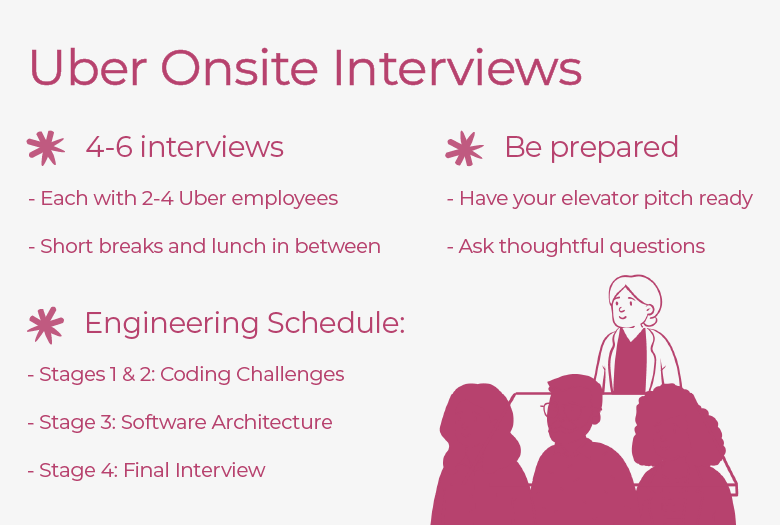
Aside from knowing your technical stuff, be prepared to talk about yourself. Uber recommends preparing an elevator pitch that sums up your prior career trajectory, current work, and future goals. The typical onsite interview consists of 4-6 back-to-back interviews, with short breaks in between, and lunch, which is an extension of the interview. Each interview consists of a panel of 2-4 Uber employees.
Technical candidates
Employees say onsite interviews for technical roles consist of five stages: two stages of coding, one stage of software architecture, lunch, and a final interview with the hiring manager. For the coding challenges, you’ll alternate between using HackerRank and a whiteboard, and you may also get questions about system design. You can solve each problem in the language of your choice. Don’t try to impress a recruiter by using a coding language you don’t know well simply because your prospective team uses it; they’ll catch you quickly.
Offer
After the onsite interview is over, your interviewers will gather in a room and upvote or downvote you. Each person will describe their impression of you, your technical skills, communication skills, and team fit. Ultimately, the hiring manager decides whether or not to proceed with an offer.
If interviewer feedback seems mixed, the recruiter may arrange an additional phone screen to clarify something that was missed during the onsite.
If Uber decides to extend an offer, you’ll hear from the hiring manager via phone or email. Beware that negotiating your salary at Uber can be tricky. Compensation packages tend to be equity-heavy, and the company rarely budges on that.
👉 Learn more about how to negotiate your salary here or set up an intro call with us.
Tips to Help You Succeed
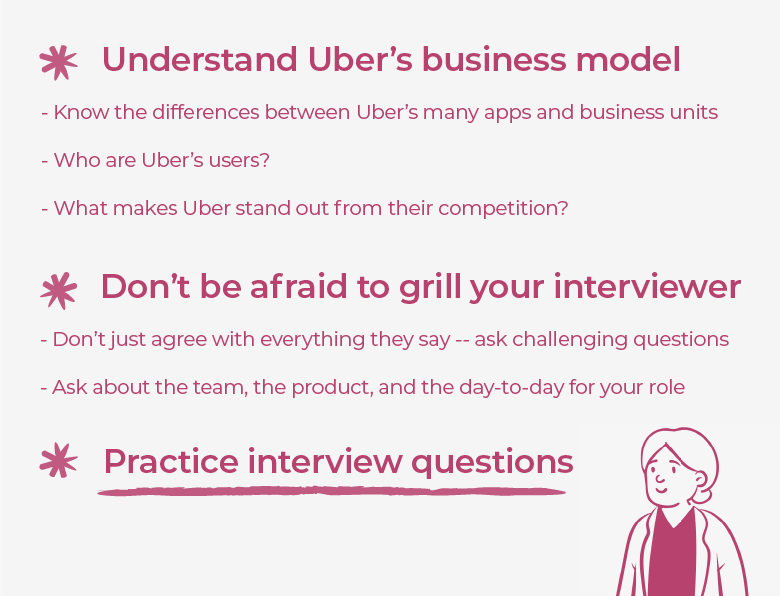
Understand Uber’s business model
If you’re interviewing for a creative role, it’s especially important for you to understand Uber’s various apps and strategic business units, including UberEats, Uber Freight, Advanced Technologies Group, and Uber Elevate.
Knowing the product includes understanding the people who use it -- both drivers and riders. What are drivers’ pain points? How is Uber’s rideshare business performing in foreign markets? How is Uber doing compared to competitors like Lyft? Comprehending these viewpoints will empower you to ask more intelligent questions and offer better solutions.
Don’t be afraid to grill your interviewer
Uber hiring managers emphasize the importance of hiring for mutual fit. They are therefore more impressed with candidates who ask challenging questions about their team, the product, and the day-to-day work than those who indiscriminately express agreement with everything their interviewer says.
Uber Interview Questions

Behavioral Questions...
- Tell me about a time you tried to do something but failed
- Tell me about a time you took the lead on a project
- Tell me about a project where you failed to communicate with senior leadership
- If you could be an expert at any skill, what would you choose?
- If you were to be hired here today, what would you want to start working on?
- What would inspire you to stay on board with us, rather than taking another role in a couple years?
- How would your friends describe you?
- Tell me about a time you optimized a process. What was the result?
Technical Questions...
- Uber Eats wants to ensure there are enough deliverers during peak periods- how do you estimate that?
- What variables will you use to model the price we should charge each restaurant? How will you model this?
- Design an a/b experimentation service that helps engineers do split testing
- Code a 4-way street light
- Design the latest search engine to rival Google
- Write a problem that solves sudoku problems and provides an error message if your solution is invalid
- Design a system that rivals PayPal
- Design an application that can send notifications to multiple devices
Performance Reviews & Refreshers
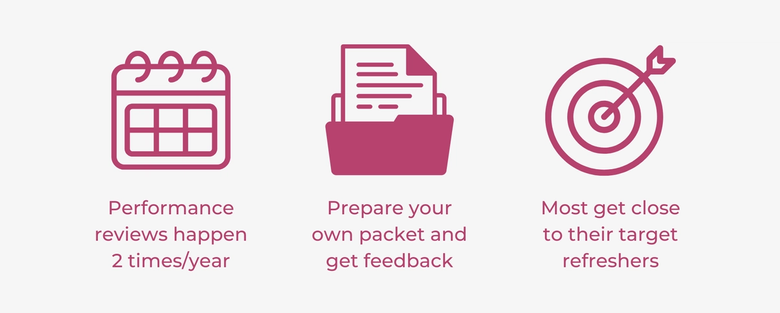
Uber has a general rule that you must remain at your current level for 1 year before being up for a promotion (though this is less strict for junior roles).
Here's the average promotion trajectory:
- L3 to L4: usually 1.5 years; some can be promoted in 1 year, but it's not typical
- L4 to L5a: this depends on your skillset; could be 2-3 years if you need to improve in certain areas
- L5a to L5b: difficult to do; 2-3 years if at all
Performance review process
Performance reviews at Uber evaluate your performance at your level, your projects, and your communication, not necessarily how long you've been with the company.
Uber has 2 performance reviews per year: 1 in June and 1 in December. During this process, you have to assemble your own packet, and you'll get feedback from 3-5 peers of your choice and your manager. Everyone will give feedback on the top things you’re doing well and where you have room for growth. Your manager will also review your competencies within your field.
You'll then get a rating of "meets," "below," or "exceeds." The expectations are based on your level. Note that Uber doesn't have a forced curve anymore, but your peers are still taken into consideration (we'll get into that below).
Some Uber employees have explained the performance review process as highly political with a lot of favoritism.
How refreshers work
At the end of the year, your bonus, refreshers, and raise are based on your performance, and your peers' performance is taken into consideration when deciding how much. If there are a lot of similar performers at your level in the "exceeds" category, then a lot of people could get slightly over target; on the other hand, if there are a few performers that stand out, then those few could get a lot over target.
Refreshers aren't guaranteed at Uber, but it's unlikely not to get them. High performers at Uber get 1-2x of the targeted amount for refreshers. This review on Blind from an Uber employee highlights this sentiment:
"They’re not guaranteed in the sense they can expand/contract based on a variety of factors, but it’s very unlikely you would ever get below 80% of the communicated target. In the same vein, it’s possible to get 2x."
The information provided herein is for general informational purposes only and is not intended to provide tax, legal, or investment advice and should not be construed as an offer to sell, a solicitation of an offer to buy, or a recommendation of any security by Candor, its employees and affiliates, or any third-party. Any expressions of opinion or assumptions are for illustrative purposes only and are subject to change without notice. Past performance is not a guarantee of future results and the opinions presented herein should not be viewed as an indicator of future performance. Investing in securities involves risk. Loss of principal is possible.
Third-party data has been obtained from sources we believe to be reliable; however, its accuracy, completeness, or reliability cannot be guaranteed. Candor does not receive compensation to promote or discuss any particular Company; however, Candor, its employees and affiliates, and/or its clients may hold positions in securities of the Companies discussed.
